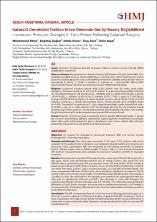Katarakt cerrahisini takiben erken dönemde göz içi basınç değişiklikleri
Citation
Batur, M., Çağlar, Ç., Demir, H., Eser, E., Yaşar, T. (2019). Katarakt cerrahisini takiben erken dönemde göz içi basınç değişiklikleri. Hitit Medical Journal, 1(1), 1-5.Abstract
Amaç: Katarakt cerrahisi sonrası göz içi basıncı (GİB) ve merkezi kornea kalınlığı (MKK) değişimlerini incelemek. Gereç ve Yöntem: Çalışmaya senil kataraktı bulunan 62 hastanın 62 gözü dahil edildi. Tüm hastalar komplike olmamış fakoemülsifikasyon ve göz içi lensi (GİL) implantasyonu içeren katarakt cerrahisi geçirdiler. GİB, nonkontakt tonometre ile katarakt ameliyatından önce ve sonrasında 3. saatte, 1. günde, 1. haftada, 2. haftada ve 1. ayda ölçüldü. GİB ve MKK ölçümleri tekrarlanan ölçümler için varyans analizleri (ANOVA) ile test edildi. Bulgular: Çalışmaya ortalama yaşları 66±12.38 (40-84) olan 62 hasta dahil edildi. Hastaların 35'i kadın (% 56.5), 27'si (% 43.5) erkekti. Preoperatif ortalama MKK 535,69 µ idi. Preoperatif ortalama GİB 14.63 (10-21) mmHg idi. GİB, 3. saatte 19,95 (9-58), 1. günde 14.50 (8-29), 1. haftada 12.83 (8-19), 2. haftada 12.91 (7-18), 1. ayda 12.72 (8-18) idi. Preoperatif GİB 14.63 mmHg iken 3. saatte istatiksel anlamlı olarak 19,95 mmHg'ya (%26) yükseldi (p30 mmHg). Bu gözlerde herhangi bir tedaviye gerek duyulmadan GİB normale döndü. Sonuç: Katarakt cerrahisi sonrası ilk saatlerde anlamlı şekilde GİB yükselmekte. 1. günde ise normale dönmektedir. GİB'teki yükselmeler sağlıklı gözlerde muhtemelen zararsızdır, fakat riskli optik diskli hastalarda geçici yükselmeler dahi zararlı olabilir. Risk altındaki hastalarda GİB yükselmesi için gerekli önlemler alınmalıdır Objective: To analyze the changes of intraocular pressure (IOP) and central corneal thickness (CCT) after cataract surgery. Material and Method: The study was composed of 62 eyes of 62 patients with senile cataract. All the patients had undergone uncomplicated phacoemulsification surgery and intraocular lens implantation. IOP was measured by non-contact tonometer at baseline before cataract surgery and on follow-upvisits 3 hours, 1 day, 1,2 and 4 weeks afterward. IOP and CCT measurements were analyzed by analysis of variance (ANOVA) for repeated measure. Results:The study was composed of 62 patients with a mean age of 66±12.38 (range, 40 to 84) years. There were 35 females (56.5%) and 27 males (43.5%). The mean CCT was 535,69 before cataract surgery.The pre-operative mean IOP was 14.63 (10-21) mmHg at baseline visit. IOP was 19,95 (9-58) at the third hours, 14.50 (8-29) at the first day, 12.83 (8- 19) at the first week, 12.91 (7-18) at the second week, 12.72 (8-18) at the first month. The mean preoperative IOP was 14.63 mmHg, which statistical significant increased to 19,95 mmHg (26%) on the 3rd hours (p0.05). The decrease in mean IOP between the postoperative first day and the first week was 1.67 mmHg. This difference was significantly different (p30 mmHg) in the pressure after the surgery. IOP was returned to normal values without antiglaucomatous medication in these eyes. Conclusion: The IOP increase significantly in the first hours following cataract surgery. It is returned to normal values in the first day of surgery. It appears that IOP increasing in healthy eyes are probably harmless, but the similar transient elevation of IOP may be detrimental in cases with compromised optic discs. Necesarry measures should be taken to increase IOP in patients at risk.


















